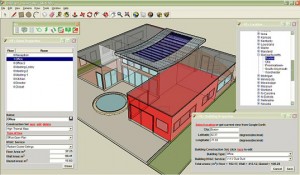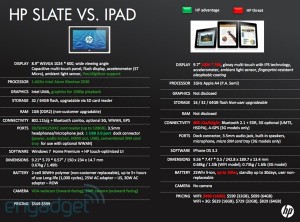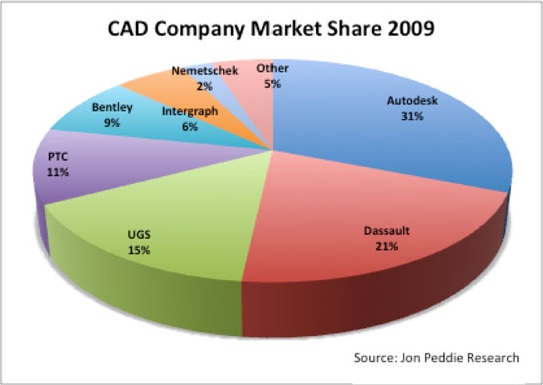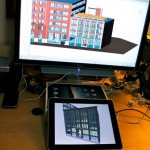Archive for category BIM
SketchUp IES Build Partnership : Energy Analysis : Building Performance : Simple BIM? : SketchUp Wins?
Posted by Jim Foster in Adoption, BIM on June 7, 2010
 Integrated Environmental Solutions (IES) recently formalized a partnership or made it more formal, actual details seem fuzzy even after reading the press release, sort of like IES and SketchUp agree to continue to working together. IES and EcoTect (now part of Autodesk) have been two of the longest standing players in the digital building analysis arena and what makes this really interesting to me is that SketchUp continues to gain traction. Users and developers are flocking to SketchUp and part of that is the magnetic power of google but also a fact is that I have architects say to me that they never used CAD in their life but now they use Sketch Up. It could be part of a larger migration to use SketchUp on the design end of the process. I can hear BIM purists, Revit Snobs and CAD managers groan and start cursing me already but hold and consider this.
Integrated Environmental Solutions (IES) recently formalized a partnership or made it more formal, actual details seem fuzzy even after reading the press release, sort of like IES and SketchUp agree to continue to working together. IES and EcoTect (now part of Autodesk) have been two of the longest standing players in the digital building analysis arena and what makes this really interesting to me is that SketchUp continues to gain traction. Users and developers are flocking to SketchUp and part of that is the magnetic power of google but also a fact is that I have architects say to me that they never used CAD in their life but now they use Sketch Up. It could be part of a larger migration to use SketchUp on the design end of the process. I can hear BIM purists, Revit Snobs and CAD managers groan and start cursing me already but hold and consider this.
- Many GCs are already building their own BIMs for projects as they have the ultimate responsibility.
- Architects are the first to admit they are designers and artists why not let them express themselves with the most intuitive tool.
- Architects want to manage the BIM process as much as they want paper cuts filled with lemon juice.
Have the architects design the project and then consult with the building of the BIM when the GCs put it together using their design as the template. The rise of virtual construction departments within the GCs themselves are well positioned for this transition and are already doing it for the most part. Why have an architectural BIM that might not be used for construction. If you can go through an iterative design process with SketchUP, utilize building performance tools from IES and then were just waiting for option analysis, rough quantity takes offs from Sketch Up you have a powerful SimpleBIM tool with a price point that is 10% that of the equivalent from Autodesk. Not that we give up on Revit, ArchiCAD, Navisworks, etc for the heavy lifting and actual BIM and construction coordination, 4D, 5D etc. but until everyone works on the same platform, ask yourself what’s the best workflow, best use of resources, best use of funds I don’t think it starts with conceptual work in Revit.
Rapid Energy Modeling : Sustainable Retrofits : The Market, Tools & Techniques : BIM
Posted by Jim Foster in BIM, Built Environment, Green, Laser BIM, Point to Point Laser Technology on May 19, 2010
There is a virtuous circle afoot and it’s not just how you spin social networking to acquire traffic it is sustainable retrofits and if you wonder what’s the next big thing, what gets us out of this economic tailspin, or at least malaise too many data points are starting to point in the sustainable retrofit direction. ARRA (American Relief and Recovery Act) money points that way, the President speaks about green jobs, Autodesk is hyping it and I am being constantly contacted from firms wanting to use our technology, PointKnown , to augment their green building practices. And the best thing about it, it makes sense, unlike pets.com which use to ship dogfood to you via fedex.
Here are some stats, most of them gleaned from an Autodesk Paper, (from the I read it so you don’t have to category).
-
Approximately 75 percent of buildings globally will be either new or have undergone significant renovation by 2035 (1)
-
About 150 billion square feet of existing buildings (roughly half of the entire building stock in the United States) will need to be renovated over the next 30 years. (2)
-
A recent analysis estimates that green building retrofits in the United States represent a $400B market in the next 20 years. (3)
(1) http://www.architecture2030.org/ (2009)
(2) American Institute of Architects (AIA) COTE (2009), Ecology and Design: Ecological Literacy in Architecture Education.
(3) Pike Research (2009), “Energy Efficiency Retrofits for Commercial and Public Buildings,” Executive Summary.
That means work up and down the line from surveying and modeling buildings, through energy analysis, the design process through constrcution. But the reason it makes most sense is that there is viable and real ROI not just from the environmental benefit but also from the energy savings. Autodesk’s argument, while self-serving, provides some valid points.
• Supplement energy benchmarking by providing numerous design alternatives to users.
• Democratize the energy and carbon footprinting process by making it accessible to a wider audience of practitioners.
• Make modeling faster, cheaper, and more likely to be used.
 Autodesk’s work flow utilizes image modeler to be imported into Revit for modeling. While personally am not a big fan of introducing another piece of software into the workflow I can see where some people will be more comfortable using photos, etc. to create geometries. PointKnown takes a different tact in utilizing PPLT (Point to Point Technology) to define objects directly into a Revit work station. That way a user can further leverage their existing software, draft in a familiar platform, and leave with a dimensionally correct model. At the end of it you can choose to leave the generic walls, windows, etc. in place for gbXML export, or energy analysis, or begin the process into defining the elements. Your choice, but you have a dimensionally correct model in the field, with no intermediate translation step. Now to get technical PPLT is best used for planar surfaces that have minimal variation, that is a wall, that’s straight, but then again typical conditions dictate most surfaces of walls be straight or are at least intended to be. And for energy analysis this could be a powerful tool to jump start the modeling, and actually make it ‘Rapid’
Autodesk’s work flow utilizes image modeler to be imported into Revit for modeling. While personally am not a big fan of introducing another piece of software into the workflow I can see where some people will be more comfortable using photos, etc. to create geometries. PointKnown takes a different tact in utilizing PPLT (Point to Point Technology) to define objects directly into a Revit work station. That way a user can further leverage their existing software, draft in a familiar platform, and leave with a dimensionally correct model. At the end of it you can choose to leave the generic walls, windows, etc. in place for gbXML export, or energy analysis, or begin the process into defining the elements. Your choice, but you have a dimensionally correct model in the field, with no intermediate translation step. Now to get technical PPLT is best used for planar surfaces that have minimal variation, that is a wall, that’s straight, but then again typical conditions dictate most surfaces of walls be straight or are at least intended to be. And for energy analysis this could be a powerful tool to jump start the modeling, and actually make it ‘Rapid’
When I say BIM what do you think? Take the Poll. #BIM
Posted by Jim Foster in BIM on May 19, 2010
Following multiple discussions through linked in and blog I am seeing a fundamental breakdown between people creating a business around BIM and those trying to implement it, some see it as an all or nothing affair, some see it like Baskin Robbins and take the flavor they like, others simply think it’s a particular piece of software. While a poll with only a few answers can hardly decide this question, let’s start the dialog.
The poll is in the sidebar, or feel free to add your comments. Or visit the Poll on Linked In:
Business of BIM v. Practice of BIM
Posted by Jim Foster in As Builts, BIM, Built Environment on May 17, 2010
 I follow a discussion on LinkedIn within the BIM Experts Group titled the Politics of BIM that has provided amusement, as much as following a discussion on BIM could possibly provide, as well as being highly informative. Two of the combatants (sic. collaborators) could not reconcile their 2 positions. One was a BIM/CAD manager that coordinated very large projects, the other was a service provider for the industry. The point of the conflict? Revit. The BIM Manager did not see Revit as a robust enough program to deal with huge projects and the needed coordination between programs, etc. The service provider highlighted Revit’s abilities and Autodesk’s suite of products. What I saw was the difference between the Business of BIM and the Practice of BIM.
I follow a discussion on LinkedIn within the BIM Experts Group titled the Politics of BIM that has provided amusement, as much as following a discussion on BIM could possibly provide, as well as being highly informative. Two of the combatants (sic. collaborators) could not reconcile their 2 positions. One was a BIM/CAD manager that coordinated very large projects, the other was a service provider for the industry. The point of the conflict? Revit. The BIM Manager did not see Revit as a robust enough program to deal with huge projects and the needed coordination between programs, etc. The service provider highlighted Revit’s abilities and Autodesk’s suite of products. What I saw was the difference between the Business of BIM and the Practice of BIM.
What I find most exciting and frustrating about the industry currently is it is wide open. The business of BIM is looking at high level needs and creating deliverables, whereas the practice of BIM is trying to coordinate large models, 4D, 5D applications etc. and getting all the disciplines to be integrated. The business and practice silos do not seem to always be to integrated and or coordinated and I can see where this causes frustration.
The BIM field is still so wide open so it is open to define in the terms of deliverables and process. For example, a Texas firm asked us for a BIM model; their only interest, as best I could decipher, was to deliver one to fulfill the Texas mandate and wanted to know little about it except for the tail light guarantee they were going to leave with their customer. I also have been asked for a Revit model by clients who have never used Revit and negotiated the contract without fully understanding what they wanted. General Contractors as the McGraw Hill SmartMarket Reports allude to and as is evidenced in the field have seemed to embrace it more quickly and understand it better and from my conversations have seen it quickly pay for itself many times over with just collision detection.
The ![]() GSA BIM Program may be the most highly documented and while government mandates can create jobs, not sure how well they can define the process and if the industry would want them to. Meanwhile we have BIM mandates while the deliverable is still being defined. In the ideal world the industry would use a centralized BIM that gets updated during design by all the disciplines so that the owner gets a true ‘as-built’ BIM at the end of the process, however, we are still a long way from there with the majority of projects, couple with the face the majority of construction is done within the built environment. What will happen is that companies will use the parts of BIM that immediately provide value whether it is energy analysis, collision detection, scheduling or just visually communicating with the client. Those will start to grow and cross pollinate each other until we have are fully realized 3D object oriented BIM universe. Use the tools you understand, the ones that make sense for your company, improve your workflow keep an open mind and don’t let the good be the enemy of the perfect.
GSA BIM Program may be the most highly documented and while government mandates can create jobs, not sure how well they can define the process and if the industry would want them to. Meanwhile we have BIM mandates while the deliverable is still being defined. In the ideal world the industry would use a centralized BIM that gets updated during design by all the disciplines so that the owner gets a true ‘as-built’ BIM at the end of the process, however, we are still a long way from there with the majority of projects, couple with the face the majority of construction is done within the built environment. What will happen is that companies will use the parts of BIM that immediately provide value whether it is energy analysis, collision detection, scheduling or just visually communicating with the client. Those will start to grow and cross pollinate each other until we have are fully realized 3D object oriented BIM universe. Use the tools you understand, the ones that make sense for your company, improve your workflow keep an open mind and don’t let the good be the enemy of the perfect.
CAD Market / BIM Market 2010 : Installed Base : Ouch.
Posted by Jim Foster in 3D, Autodesk, BIM, economic trends, Installed Seats on May 6, 2010
So earlier in these ruminations I stated that I thought 30% less was the new watermark, that is, 30% less work out there, 30% off what used to be a winning bid. Early market data from Jon Peddie Research, shows a 22% drop in 2009 CAD revenues as compared to 2010. This is just on the software side, not services, which we can argue would be worse. Subscriptions are down because why renew an empty seat as are new sales. This report deals with CAD on all levels from designing parts to designing buildings but still gives a good overview of the industry. The good news for those embracing BIM is that they reaffirm other anecdotal information that BIM is a bottom up phenomena not a mandate from management. That is, the people building the buildings are the ones who are using not because of perceived value or marketing spin but because it adds value. Hammer..check…Compressor…check…BIM model…
Updated Aug 2010
I noticed a lot of traffic to this page, and also noticed that the link to the report required a log in so decided to quote it here.
Let’s just get this over with: the year 2009 was a disaster in the CAD industry. According to our latest report, the CAD industry saw revenues of $5.1 billion, a 22% drop compared to 2008 and although the picture is improving for 2010, there is no rebound because that’s just not the way the CAD industry works, and worse, that’s not how this recession worked.
The CAD industry cannot turn on a dime because it’s part of larger systems. At this year’s Autodesk University, Carl Bass noted that subscriptions were down because there’s not much reason to maintain a subscription for empty seats. Unfortunately, there are a lot of empty seats for all CAD systems worldwide. We estimate that approximately 200,000 workers left the CAD industry worldwide. And, it can be added, we believe this is a conservative view.
In this latest report we have seen an interesting trend as Building Information Modeling (BIM) becomes accepted in the engineering, architecture and construction (AEC) industry. The similar discipline, PLM is just about ubiquitous in MCAD but as it was being introduced into the MCAD industry in the early 90s, it was essentially implemented in a top-down process as management signed up for the advantages that come with a consistent and connected data pipeline. In contrast, BIM in the architectural fields is being driven by those at the end of the pipeline in building and construction.
Business Rant : One of Many: #BIM #AIA
Posted by Jim Foster in architects, BIM, economic trends, Entrepreneurship on April 28, 2010
30%, that’s the figure that keeps coming back to me, business is down 30% and competitive bids are 30% less than what they used to be. I even had firms we do business with in India essentially say, “I am not going down the rathole.” You have got to be creative to deal with it. It reminds of a an accounting professor in business school who extolled, “all costs are variable,” not really but you get the point. Renegotiate rents, bargain with your workforce, create partnerships to fill holes, man it stretches the imagination which is good, however there is no reality like payroll, and rent, and insurance, etc. There was a recent article in the Las Vegas Business Press, “From Boom to Bust,” that echoes these themes. One GC stated that, ‘Our revenue in 2010 will be slightly less than half of what it was in 2008.” Bidders on projects have multiplied by 3, and successful bids seemed to be 40% below 2008 highs.
“Cash flow is the king during a recession,” Perini Building Co. Vice Chairman Dick Rizzo said. “As the economy shrinks, prompt payment is important. In some cases, it’s the only source of income to subcontractors and vendors.” This statement brings me to my next point, when did we ever, and architecture firms I am looking at you, get to a point where this statement is the norm, ‘you get paid when we get paid.’ Holy $$$$. This is patently ridiculous. There was a good article in the Boston Business Journal that said free lancers and sub contractors are spending as much time tracking down payments and getting paid as they did on the actual project. So looking at that vice of lower winning bids and taking forever to get paid what’s a small business to do? You can whine about it, not much help, or try and figure it out. I don’t even say make lemonade from lemons, this is strictly survive than thrive. To the ‘you get paid when we get paid’ again who ever agreed to that, but if your on the short end of that scenario consider starting a relationship with a factor, otherwise known a receivable financing, different companies specialize for different industries and even by size of receivables but there is one out there for you. They will take 1-3 points monthly but nothing like cash flow. As for some of the advice you get such as put penalties in your contract, talk directly to payroll, etc. most them will stay with the partly line, and a lot replace contracts you may have put together with their own which certainly does not have any late payment penalties.
As for multiple bidders and reduced winning bids, know your costs, use BIM, be ready for hard bids. It’s telling that GCs are the early adopters to BIM, Revit and the like and embracing their 4D and 5D aspects.
Partner up, can you still offer the same level or service as you could in 2008? Can you offer more today? More companies may be more willing to work together. Like I tell my kids, ‘the answer is always no unless you ask.’
Flexible BIM Pricing
Posted by Jim Foster in BIM, SaaS on April 9, 2010
 Graphisoft continues to lead with flexible pricing models for their BIM authoring software package, ArchiCAD 13. More popular overseas, Graphisoft first introduced their Star(t) addition priced at $1995 and now introduced ArchiCADRental (ACR). ACR allows users to flex into ArchiCAD based on need and essentially usage. Allowing users varying price points to get into a BIM package is definitely a good thing, I think the ACR model tests the waters for a demand / SaaS based model. Initially, the model allows for 1, 3, 6 month and 1 Year pricing models.
Graphisoft continues to lead with flexible pricing models for their BIM authoring software package, ArchiCAD 13. More popular overseas, Graphisoft first introduced their Star(t) addition priced at $1995 and now introduced ArchiCADRental (ACR). ACR allows users to flex into ArchiCAD based on need and essentially usage. Allowing users varying price points to get into a BIM package is definitely a good thing, I think the ACR model tests the waters for a demand / SaaS based model. Initially, the model allows for 1, 3, 6 month and 1 Year pricing models.
iPAD : BIM : Game Changer?
Posted by Jim Foster in BIM, New Technologies on April 8, 2010
 The launch of the iPad has brought a lot of focus back to the tablet or I guess we need to call it a slate. Nevermind that tablets have been commercially available for over a decade; however commercial success has always seemed to elude it. Lack of killer apps, increased expense compared to regular laptops certainly contributed but perhaps it was the change in the UI (User Interface) zeitgeist that provided a bigger hurdle. Apple introduced the world, in a largely commercially way, to the multi-touch interface with the iphone making many comfortable with the concept and its app store was a huge success with many programs priced around a $1 made it the equivalent of an impulse purchase at the Walgreen’s check out line. With the release of the ipad Apple has upped the ante, not just because of the user interface but with a mobile platform that is relying mostly on the web to deliver applications/data/multi-media/snacks/beverages much like the ‘thin-client’ devices promised to us in the nascent days of the interweb. So the question is does the iPad have the power/features/connectivity to matter in the A/E/C Industry, and if so who needs it as an always on, apple form factor in the field?
The launch of the iPad has brought a lot of focus back to the tablet or I guess we need to call it a slate. Nevermind that tablets have been commercially available for over a decade; however commercial success has always seemed to elude it. Lack of killer apps, increased expense compared to regular laptops certainly contributed but perhaps it was the change in the UI (User Interface) zeitgeist that provided a bigger hurdle. Apple introduced the world, in a largely commercially way, to the multi-touch interface with the iphone making many comfortable with the concept and its app store was a huge success with many programs priced around a $1 made it the equivalent of an impulse purchase at the Walgreen’s check out line. With the release of the ipad Apple has upped the ante, not just because of the user interface but with a mobile platform that is relying mostly on the web to deliver applications/data/multi-media/snacks/beverages much like the ‘thin-client’ devices promised to us in the nascent days of the interweb. So the question is does the iPad have the power/features/connectivity to matter in the A/E/C Industry, and if so who needs it as an always on, apple form factor in the field?
Processing power and GB of RAM, BIM tools are hogs so any true BIM authoring software would have to run remotely and accessed through the iPad or similar slate, and then the bottleneck becomes the latency in the broadband connection, in this case, most likely the 3G connection unless you have public wifi on your job site. And that would bring us back to something like Project Twitch from Autodesk which allows you remote control their products through an internet connection, since I don’t have an ipad I can’t vouch yet for how that would work but having your project stored remotely and using the ipad to drive through it that starts to get interesting.
goBIM which was released for the iphone, yes you read that right is running on the ipad. It is a BIM viewer that has an exporter API that will let you translate Revit and Rhino models into its own format. Why’s it’s own format? Visit the site for the FAQ and explanation but it seems as it matures the developer wants it to be an xml format.
One company focused on bringing BIM to field, an aptly calling it FieldBIM, Vela Systems blogged about the ipad, and beyond reiterating iPad specs and blogosphere pronouncements ends with a ‘we’ll have to wait and see.’ One of their  prerequisites though was a field case which is already available at HardCandy. Additionally, they have partnered with Motion Computing to provide ruggedized tablets for the FieldBIM. However, what we all just really want is to unlock data that is stuck in file rooms or servers and be able to interact with it in a meaningful way which seems to be Apple’s sweet spot.
prerequisites though was a field case which is already available at HardCandy. Additionally, they have partnered with Motion Computing to provide ruggedized tablets for the FieldBIM. However, what we all just really want is to unlock data that is stuck in file rooms or servers and be able to interact with it in a meaningful way which seems to be Apple’s sweet spot.
 Counterbalancing Apple’s offering is the new HP Slate, which is essentially a slate wearing Windows 7 clothing and I am not sure how compelling an argument that is going to be as we’ve had a tablet edition of XP for a long time, is a multi-touch version going to sway a lot of people? Comes down to the applications and how they are served? If they are running remotely, who does the best job with the interface because the slate/pad whathaveyou is just the conduit. Which brings us to what might be the real game changer and that is the Google Chrome OS, open source/operating system, which doesn’t care what device you use and will just deliver it, this web centric open model seems more in line with our egalitarian nature and should increase adoption. But what keeps nagging at me is Apple’s tremendous execution and if their closed ecosystem produces field tools for the laymen then they got something going on, maybe break the functionality into bits, collision bits, scheduling bits, so the app provides not just the CM with a tool but workers who can use an app designed for their function, punch list, update, done. And that has been the beauty off the app store, essentially singularly focused bits that are easy to understand and implement. So if we have the true BIM up in a cloud and all these specific apps interfacing with it, that would be the equivalent of the web with user generated content (UGC) driving the system, and not the bloatware cloud we’ve been living under. It will be in the execution, otherwise you might be seeing people treating them more like Daniel Tosh did.
Counterbalancing Apple’s offering is the new HP Slate, which is essentially a slate wearing Windows 7 clothing and I am not sure how compelling an argument that is going to be as we’ve had a tablet edition of XP for a long time, is a multi-touch version going to sway a lot of people? Comes down to the applications and how they are served? If they are running remotely, who does the best job with the interface because the slate/pad whathaveyou is just the conduit. Which brings us to what might be the real game changer and that is the Google Chrome OS, open source/operating system, which doesn’t care what device you use and will just deliver it, this web centric open model seems more in line with our egalitarian nature and should increase adoption. But what keeps nagging at me is Apple’s tremendous execution and if their closed ecosystem produces field tools for the laymen then they got something going on, maybe break the functionality into bits, collision bits, scheduling bits, so the app provides not just the CM with a tool but workers who can use an app designed for their function, punch list, update, done. And that has been the beauty off the app store, essentially singularly focused bits that are easy to understand and implement. So if we have the true BIM up in a cloud and all these specific apps interfacing with it, that would be the equivalent of the web with user generated content (UGC) driving the system, and not the bloatware cloud we’ve been living under. It will be in the execution, otherwise you might be seeing people treating them more like Daniel Tosh did.
Spin Cycle BIM: UniMac Adds BIM Library
Posted by Jim Foster in BIM, economic trends on March 31, 2010
BIM contin ues to cross pollinate industries. According to American Laundry News (I’ll read it so you don’t have to) UniMac a manufacturer of on premise laundry equipment is now providing BIM objects of their most popular models. This, of course, allows the AEC community to incorporate them with their designs from a spatial sense and also coordinate utilities for hook up. Ideally warranty and manual information is tagged to the object as well so one object becomes a one stop shop of information, maintenance logs, etc. The bigger idea is what’s your BIM strategy? As the internet opened up a world of information about, well, everything BIM is opening up a new world of information.
ues to cross pollinate industries. According to American Laundry News (I’ll read it so you don’t have to) UniMac a manufacturer of on premise laundry equipment is now providing BIM objects of their most popular models. This, of course, allows the AEC community to incorporate them with their designs from a spatial sense and also coordinate utilities for hook up. Ideally warranty and manual information is tagged to the object as well so one object becomes a one stop shop of information, maintenance logs, etc. The bigger idea is what’s your BIM strategy? As the internet opened up a world of information about, well, everything BIM is opening up a new world of information.
I equate this next step in the internet and technology from going to the big bang, ‘wooaha new universe’ to galaxies to planets and these are starting get populated with more information and relevant data. The AEC industry is starting to break down from macro trends, etc. the complete life cycle of a building and how each decision effects it. There is a world of information and opportunity within this world. For example, UniMac just made it easier for a designer to spec their machines. What company wants the contract to keep the data and maintenance logs up to date for those machines within this BIM world, who wants the actual maintenance contract and which companies are plugged into take advantage of that entire life cycle, not just the building but almost every object in it.
Balkanized BIM: IPD -> VDC -> HPBMS -> Lean -> LPDS
Posted by Jim Foster in BIM on March 30, 2010
What the… It’s like alphabet soup and it’s also like the wild west out there, everyone staking their claim, evangelizing, growing their camps…but what’s it really mean. To me, and I’m lucky as we provide mostly the BM, not a very attractive acronym I realize as soon as I type it, but we provide the building model and then there is a whole lot of work to fill in the ‘I’ (Information) but what my position does afford me is to see how people are using these tools, how they understand them and what they hope to accomplish, but first lets decipher the soup and to me they break down into the majors (concepts) and the minors (processes).
Majors
BIM – Building Information Model.
VDC – Virtual Design and Construction
IPD – Integrated Project Delivery
Lean / Lean Construction
Minors
HPBMS – High Performance Building Management Systems
LPDS – Lean Production Delivery System (not sure I should have added this one but it came out Lean Construction Institute) and, well it fit well into the schema.
Well, what’s the point? I will go back to quoting a GC we worked for, who was one of the first to ask us for a Revit model of an existing building. ‘We now have the time and inclination to do things right’ This was as the real estate bubble was bursting, bids were more competitive and clients asking for hard bids. Loans had dried up. The old ways of doing things just did not seem to work or feel right and the lowest hanging fruit was putting together a building digitally, go over design options, costs, maintenance costs of those options going forward, operating costs for your choices, choosing, unearthing design problems digitally before a shovel hits the round, minimize change orders, get a building up quicker, for less money, and of equal or better quality with a firm assurance of what that building might cost you to run in the future, as the total life cycle costs of the building end up dwarfing the costs to build it.
So put any wrapper around it you want but it is about building digitally, communicating with your peers, subs, and anyone else who has a stake in it and getting it done. The playbook? Well that’s where we see all the acronyms come in and consultants forming and practices starting to help guide firms through this. My experience has been that GCs were the first to really adopt this, and the good ones have been through it, at least from the construction end, but there is a lot more learn, streamline and go through before there will be anything close to best practices (digitally) across all disciplines so I hope you like soup…But in the end, it’s like grandma says, ‘it’s good for you.’



